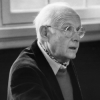Henri Cartier-Bresson

Henri Cartier-Bresson
Henri Cartier-Bressonwas a French humanist photographer considered the master of candid photography, and an early user of 35 mm film. He helped develop street photography, and approvingly cited a notion of the inevitability of a decisive moment, a term adopted as the title for his first major book. His work has influenced many photographers...
NationalityFrench
ProfessionPhotographer
Date of Birth22 August 1908
CountryFrance
photography cutting reality
Reality offers us such wealth that we must cut some of it out on the spot, simplify. The question is, do we always cut out what we should?
inspiration reality thinking
Poetry is the essence of everything, and it’s through deep contact with reality and living fully that you reach poetry. Very often I see photographers cultivating the strangeness or awkwardness of a scene, thinking it is poetry. No. Poetry is two elements which are suddenly conflict — a spark between two elements. But it’s given very seldom, and you can’t look for it. It’s like if you look for inspiration. No, it just comes by enriching yourself and living.
reality thinking discovery
Rene Char wrote somewhere, apropos poetry, that there are those who create and those who discover; they are too completely different worlds. Photograph also has two sides to it and thank goodness, I am only intersted in those who discover; I feel a certain solidarity with those who set out in a spirit of discovery; I think there is much more risk invovled in this than in trying to create images; and in the end, reality is more important.
photography reality want
The photograph itself doesn't interest me. I want only to capture a minute part of reality.
reality lasts last-words
Everyone has got some preconceptions, but you have to readjust them in front of reality. Reality has the last word.
photography reality joy
To photograph is to hold one's breath, when all faculties converge to capture fleeting reality. It's at that precise moment that mastering an image becomes a great physical and intellectual joy.
cannot deal develop earth memory vanished
We photographers deal in things which are continually vanishing, and when they have vanished there is no contrivance on earth can make them come back again. We cannot develop and print a memory.
photography real responsibility
The intensive use of photographs by mass media lays ever fresh responsibilities upon the photographer. We have to acknowledge the existence of a chasm between the economic needs of our consumer society and the requirements of those who bear witness to this epoch. This affects us all, particularly the younger generations of photographers. We must take greater care than ever not to allow ourselves to be separated from the real world and from humanity.
memories vanishing print
We cannot develop and print a memory.
photography technology important
Pictures, regardless of how they are created and recreated, are intended to be looked at. This brings to the forefront not the technology of imaging, which of course is important, but rather what we might call the eyenology (seeing).
photography organization facts
Photography is simultaneously and instantaneously the recognition of a fact and the rigorous organization of visually perceived forms that express and signify that fact
photography too-late leica
During the work, you have to be sure that you haven't left any holes, that you've captured everything, because afterwards it will be too late.
photography running believe
The only thing which completely was an amazement to me and brought me to photography was the work of Munkacsi. When I saw the photograph of Munkacsi of the black kids running in a wave, I couldn't believe such a thing could be caught with the camera. I said, 'Damn it', I took my camera and went out into the street.
moving eye perspective
A photographer’s eye is perpetually evaluating. A photographer can bring coincidence of line simply by moving his head a fraction of a millimetre. He can modify perspectives by a slight bending of the knees. By placing the camera closer to or farther from the subject, he draws a detail. But he composes a picture in very nearly the same amount of time it takes to click the shutter, at the speed of a reflex action.